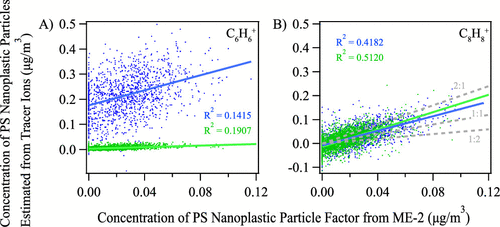
Quantifying the Chemical Composition and Real-Time Mass Loading of Nanoplastic Particles in the Atmosphere Using Aerosol Mass Spectrometry
Sining Niu, Ruizhe Liu, Qian Zhao, Sahir Gagan, Alana Dodero, Qi Ying, Xingmao Ma, Zezhen Cheng, Swarup China, Manjula Canagaratna, and Yue Zhang
Environmental Science and Technology
Environ. Sci. Technol. 2024, 58, 7, 3363–3374
Publication Date: February 8, 2024
Copyright © 2024 The Authors. Published by American Chemical Society.
This publication is licensed under CC-BY 4.0.
OPEN ACCESS
Abstract.
Plastic debris, including nanoplastic particles (NPPs), has emerged as an important global environmental issue due to its detrimental effects on human health, ecosystems, and climate. Atmospheric processes play an important role in the transportation and fate of plastic particles in the environment. In this study, a high-resolution time-of-flight aerosol mass spectrometer (HR-ToF-AMS) was employed to establish the first online approach for identification and quantification of airborne submicrometer polystyrene (PS) NPPs from laboratory-generated and ambient aerosols. The fragmentation ion C8H8+ is identified as the major tracer ion for PS nanoplastic particles, achieving an 1-h detection limit of 4.96 ng/m3. Ambient PS NPPs measured at an urban location in Texas are quantified to be 30 ± 20 ng/m3 by applying the AMS data with a constrained positive matrix factorization (PMF) method using the multilinear engine (ME-2). Careful analysis of ambient data reveals that atmospheric PS NPPs were enhanced as air mass passed through a waste incinerator plant, suggesting that incineration of waste may serve as a source of ambient NPPs. The online quantification of NPPs achieved through this study can significantly improve our understanding of the source, transport, fate, and climate effects of atmospheric NPPs to mitigate this emerging global environmental issue.
